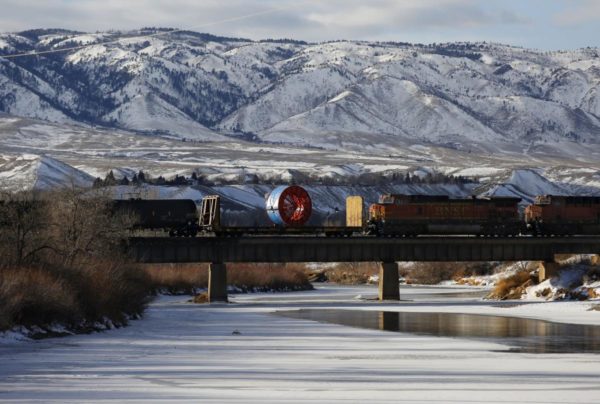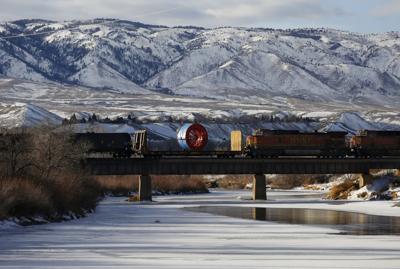States, federal government renew Platte River agreement

A BNSF train crosses a bridge over the North Platte River on Jan. 26, 2018 in Casper.
Alan Rogers, Star-Tribune
Spanning more than 10,000 acres of sensitive riparian habitat over three states, the Platte River system is one of the high plains’ most vital ecosystems, supporting swaths of human and animal populations in one of the continent’s most arid climates.
More than a decade ago, the region was also one of the nation’s most threatened.
Home to several endangered species, Nebraska’s Platte River and its northern and southern tributaries in Colorado and Wyoming was once the focus of environmentalists and high plains farmers alike, a critical spring for farmland that simultaneously, sustained fragile populations of species like the whooping crane, the pallid sturgeon and the piping plover.
These creatures – since the enactment of the Endangered Species Act in the 1970s – had been a source of concern both for naturalists and humans who relied on their habitats for sustenance, a regulatory hurdle as well as a moral burden for those who made their livings off the land and whose activities led to the decline of one of the most significant habitats for migratory waterfowl in the Midwestern United States.
For years, environmentalists as well as government officials worked to devise a way to balance both of these interests, culminating in 2006’s Platte River Program – a Bureau of Reclamation-led cooperative agreement between the three states more than a decade in the making.
In the time since its passage, the program has been lauded by experts as a “true success story” in cooperative environmentalism, described by David M. Freeman in his 2010 book on the agreement as an effort by the states to “transcend their narrower self-interests” to produce a truly collaborative approach to solving a significant environmental question of their time. A 50-50 conservation effort between the federal government and the states, the program marked a watershed moment for conservation in the high plains, helping to implement an effective water management and conservation strategy in an ecosystem relied on for millions in economic activity and for the survival of dozens – if not hundreds — of species living on its shores.
“These states and communities were facing some serious issues with endangered species 13 years ago,” Bureau of Reclamation Commissioner Brenda Burman told the Star-Tribune in an interview Tuesday. “And instead of the federal government or the states coming in with the hammer of regulation, we all worked together. This is a success story of local state and federal partnerships, and an example to the rest of the country about how things should be done.”
The work they’ve done, Burman said, is not over yet. As part of a federal spending agreement passed by Congress and signed by President Donald Trump last week, the program will continue on for another 13 years, the states and the feds committing an additional $156 million in funding for the program through 2032.
$30 million of that funding will come from Wyoming.
“We want to make sure the successes we’ve achieved in the last 13 years are maintained, that we maintain the investments we’ve made in habitat and in infrastructure,” Burman said. “But we also know there’s more to do, and while we’ve had some great returns on the endangered species, we also need to know what can happen in the future. If a major drought was to happen in the area, we need to know if we have the supplies we need. That’s something we’re still working on, and something the investments going forward will work on.”
The program — which was spearheaded by Wyoming Sen. John Barrasso during the appropriations process — will provide resources to ensure compliance for four species covered under the Endangered Species Act (ESA) living in the region, allocating funding to support a number of new and existing water-related projects in the Platte River Basin. Examples include the Bureau of Reclamation’s Big-Thompson Project on the South Platte River in Colorado and the North Platte Project in Wyoming and Nebraska, an extensive irrigation program spanning 111 miles of river.
While controversial throughout the 1990s – primarily because the depletion of water levels seen in the basin at the time put states at risk of violating the conditions of the Endangered Species Act – both the introduction of a new sense of regulatory certainty in the area as well as the tangible recovery of species in the region has given Burman confidence that the program has been a success, and exemplary of what state and local partnerships should look like.
“I think there’s always bumps along the road,” Burman said. “If you talk to folks back in the 1990s and early 2000s, I think there were a lot of concerns about this moving forward. But one of the things I did hear that isn’t always true in other places is that this program brought together partnerships – they promised to collaborate. They created a governance structure here that is different than in other places that’s innovative, that we’ve proved works. Yes, there are always concerns at the beginning, and there are always concerns about specific areas, but when we look back over the last 13 years, I think everyone will tell you this has been a big success.”
That ethos was echoed by Gov. Mark Gordon, who lauded the program’s success upon his renewed commitment to the agreement.
“The Platte River Recovery Implementation Program has brought together three states, environmental groups, water users, and two federal agencies to forge a common goal of balancing existing use with an eye towards recovery for four threatened and endangered species,” Gordon said in a statement. “This program has ensured that Wyoming continues existing water uses in the South and North Platte River Basins while making measurable contributions to species recovery.”









